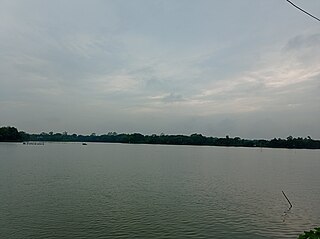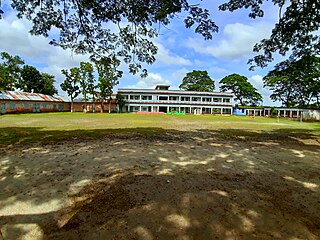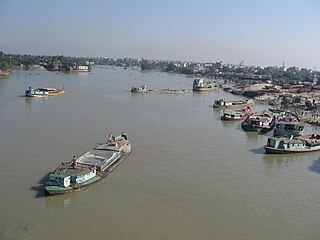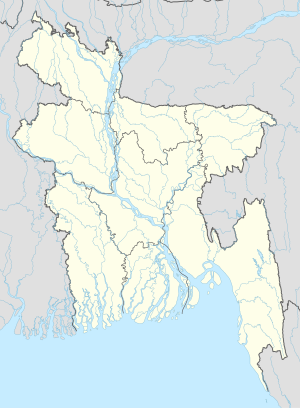
Jamalpur District is a district in Bangladesh, part of the Mymensingh Division. It was established in 1978. It has its headquarters in Jamalpur.

Netrokona District is a district of Mymensingh Division in north-east of Bangladesh.

Gazipur District is a district in central Bangladesh, that is part of the Dhaka Division. It has an area of 1806.36 km2. It is the home district of Tajuddin Ahmad, the first Prime Minister of Bangladesh and has been a prominent centre of battles and movements throughout history. Gazipur is home to the Bishwa Ijtema, the second-largest annual Muslim gathering in the world with over 5 million attendees. The district is home to numerous universities, colleges, the Bangabandhu Sheikh Mujib Safari Park, Bhawal National Park as well as the country's only business park - the Bangabandhu Hi-Tech City.

The Bishwa Ijtema is an annual gathering of Muslims in Tongi, by the banks of the River Turag, in the outskirts of Dhaka, Bangladesh. The Ijtema is considered a demonstration of Muslim unity, solidarity, mutual love and respect and an opportunity to reiterate their commitment to Islamic values. It is the biggest festival by population in Bengali culture, one of the largest peaceful gatherings in the world, and the second-largest Muslim gathering, with 5 million adherents, after the Arba'een Pilgrimage's 15–20 million attendees in Iraq, both surpassing the 2–3 million worshipers who participate in the Hajj, considered to be one of the five pillars of Islam, in Saudi Arabia. Bishwa Ijtema is a modern event where Muslim participation is voluntary.

Dhaka District is a district in central Bangladesh, and is the densest district in the nation. It is a part of the Dhaka Division. Dhaka, the capital of Bangladesh, and rests on the eastern banks of the Buriganga River which flows from the Turag to the southern part of the district. The former Dhaka city corporation occupied only about a fifth of the area of Dhaka district until 2011 where the municipal corporation was fractionated and rearranged in North and South corporations due to being the economic, political and cultural centre of the district and also the country. Dhaka District consists of Dhaka city, Keraniganj, Nawabganj, Dohar, Savar and Dhamrai upazila. Dhaka District is an administrative entity, and like many other cities, it does not cover the modern conurbation which is Greater Dhaka, which has spilled into neighbouring districts, nor does the conurbation cover the whole district, as there are rural areas within the district.

Gazipur Sadar is an upazila (sub-district) of the Gazipur District in central Bangladesh, part of the Dhaka Division.

Kaliakair is an upazila (sub-district) of the Gazipur District in central Bangladesh, part of the Dhaka Division.

Fulbaria is an upazila of the Mymensingh District in Bangladesh.

Ishwarganj is an administrative area in north-eastern Bangladesh. It is an upazila in Mymensingh District.

Khaliajuri is an upazila (sub-district) of the Netrokona District in Bangladesh, part of the Mymensingh Division.

Uttara Model Town or simply Uttara is a neighbourhood of Dhaka, the capital of Bangladesh. The name derives from the Bengali word uttor meaning "north". It lies on the road to Gazipur, and adjoins Hazrat Shahjalal International Airport.

Turag River is the upper tributary of the Buriganga, a major river in Bangladesh. The Turag originates from the Bangshi River, the latter an important tributary of the Dhaleshwari River, flows through Gazipur and joins the Buriganga at Mirpur in Dhaka District. It is navigable by boat all year round.

Bhawal National Park is a nature reserve and national park of Bangladesh.

The Bangshi is an important river in central Bangladesh. It originates in Jamalpur, from the course of the old Brahmaputra and flows past the Madhupur tract. It flows through Tangail and meets the Tongi in Ghazipur. It passes near Jatiyo Smriti Soudho in Savar and falls into the Dhaleshwari. About 238 kilometres (148 mi) long, it is not navigable for most of the year except when swelled by the monsoon rains. Louhajang River is a tributary of the Bangshi. Dhamrai on the banks of the Bangshi is famous for its muslin weaving.
The Tongi–Bhairab–Akhaura line is a railway line connecting Tongi and Akhaura, via Bhairab Bazar in Bangladesh. There is a branch line from Bhairab Bazar to Mymensingh via Gouripur. These tracks are under the jurisdiction of Bangladesh Railway.
Uttar Khan is a Thana of Dhaka District in the Division of Dhaka, Bangladesh.
Khilkhet Thana is a thana (sub-district) of Dhaka, Bangladesh. It was created in 2005.
Turag Thana is a thana, an administrative unit, in Dhaka City, Bangladesh. Turag Thana police station is the designated police station of the thana.

Tongi Junction Railway Station is a railway station in Bangladesh located in Tongi, Gazipur District. It is a station between Dhirashram and Dhaka Airport railway station. It is about 5 km north of the airport station and about 12 km south of Joydebpur. The station is served by two dual gauge lines and two platforms. Tongi–Bhairab–Akhaura line starts from this station. During the Bishwa Ijtema, it become a hub of communication and additional trains plied the station.

New Dhaka, is an unofficial term used to describe the area located north of Old Dhaka that has been incorporated in the city of Dhaka, the capital and largest city of Bangladesh over time. The term is ambiguous, as it may refer either to upscale and/or planned neighbourhoods with wider streets, modern buildings, and improved facilities, or to the city of Dhaka excluding the Old Dhaka region.




















